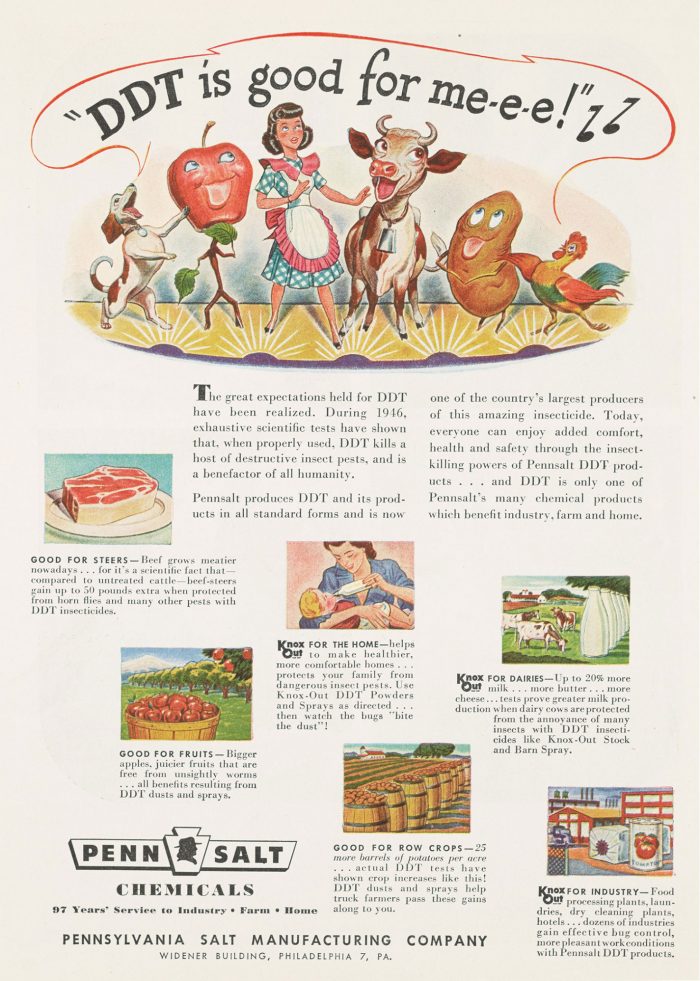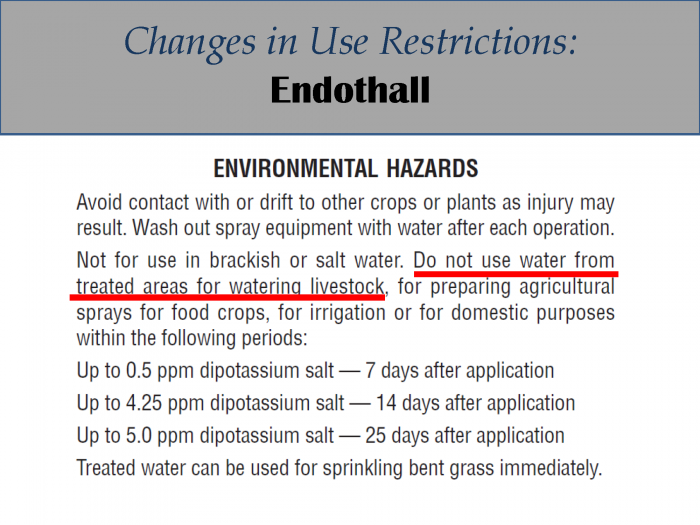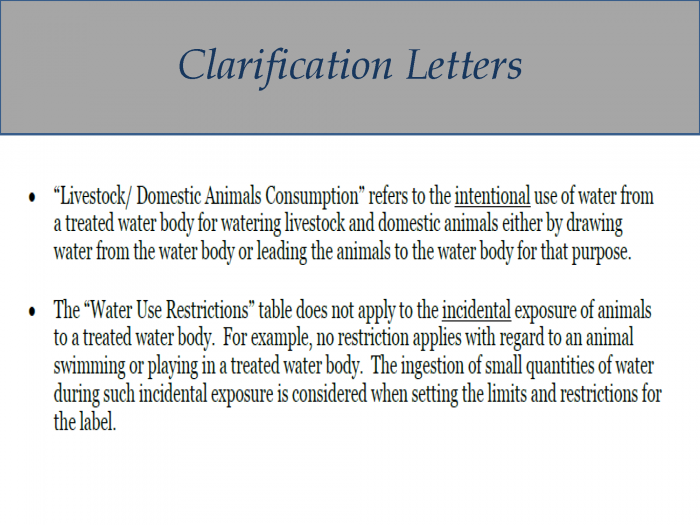At AAM, we’re ethical & environmentally conscious. Our commitment to safety and the environment is evident in our daily business practices. We’re passionate about conducting vegetation control while protecting the environment, we use only EPA registered herbicides, and we are 100% compliant with pesticide regulations to the letter of the label. When you choose AAM, you can rest assured that you’re making a conscious decision to help protect the environment.
Occasionally, a concerned individual will raise a question regarding the safety of the herbicides we apply and what safeguards we keep in place to protect people, wildlife, and the surrounding environment. These are all valid, important questions. Rest assured that AAM has the scientific understanding and the documentation to demonstrate the safety of our practices.
The science of safety and pesticide regulation is a particular passion of ours. While this article will serve to dispel any concerns over our practices, we also hope to convey our level of passion and integrity that makes AAM a company worthy of your trust.
What is AAM’s specific commitment to protecting its customers and the environment?
The long answer to this question goes much deeper into our company culture. At AAM we take great care in the training, certification, and continuous education of our people. We, figuratively and literally, go the extra mile to correctly interpret and apply the law as it pertains to pesticide applications in order to ensure the safety of our team, our customers, wildlife, and the environment exposed to our applications. When it comes to safety and following the law, we stand on principle and will not budge.
It turns out, when you are passionate about and diligent in your work, and when you are led by principles left unshaken by inconvenience and shifting circumstances, folks take notice. As a 31 year veteran of our industry and resident steward of safety and regulatory compliance at AAM, I was honored by Dr. Ken Langland of UF/IFAS when he requested that I give a presentation at the Southeast Herbicide Applicators Conference (SEHAC). This presentation was to be on the topic of reading and interpreting pesticide labels correctly and frequently for safety and regulatory compliance.
More on this topic to come.
But first, what is UF/IFAS and why should you care?
The University of Florida is the world center for aquatic plant management. It is home to the Center for Aquatic and Invasive Plants (CAIP). The UF / IFAS Center for Aquatic and Invasive Plants is a multidisciplinary research, teaching and extension unit directed to develop environmentally sound techniques for the management of aquatic and natural area weed species. The scientists and professors at CAIP are the industry scholars, providing the science, training, guidance and essential oversight to the entire aquatic and invasive plant industry.
CAIP participates extensively in applicator training sessions — sessions which we have our applicators frequently attend for continuous education and improvement. Some choose to participate in sessions at Florida Aquatic Plant Management Society (FAPMS), an industry society whose mission it is to provide the education and resources necessary to support responsible stewardship of Florida’s aquatic ecosystems through comprehensive plant management. Others participate in the Southeast Herbicide Applicators Conference, the Aquatic Weed Control Short Course, or other trainings. These conferences and trainings bring together applicators, educators, and industry representatives to learn new techniques and refresh core competencies in aquatic and upland vegetation control. Regardless of which path our applicators follow, it is evident that CAIP is deeply invested in the science and education of environmental stewardship and best practices.
So, what prompted a senior fellow from UF/IFAS CAIP to request AAM give a talk at SEHAC on FIFRA (Federal Insecticide, Fungicide, and Rodenticide Act) compliance? Simply put: To ease the widespread ignorance and bad behavior plaguing our industry.
There are a multitude of individuals and companies providing services in the aquatic and invasive species industry; however, the unfortunate reality is, unlike AAM, whether in ignorance or willful neglect, not every service provider is operating within legal compliance of the law.
What is the law?
The law is stated and governed by the Federal Insecticide, Fungicide, and Rodenticide Act (FIFRA), enacted in 1947 and placed under the responsibility of the EPA in 1972. FIFRA provides for federal regulation of pesticide distribution, sale, and use.
All pesticides distributed or sold in the United States must be registered (licensed) by the EPA. Before the EPA may register a pesticide under FIFRA, the applicant must show, among other things, that using the pesticide according to specifications “will not generally cause unreasonable adverse effects on the environment.”
FIFRA defines the term “unreasonable adverse effects on the environment” to mean: “(1) any unreasonable risk to man or the environment, taking into account the economic, social, and environmental costs and benefits of the use of any pesticide, or (2) a human dietary risk from residues that result from a use of a pesticide in or on any food inconsistent with the standard under section 408 of the Federal Food, Drug, and Cosmetic Act.”
Why FIFRA?
Prior to FIFRA there was no strength of law behind what pesticide applicators did. This is how we ended up with horror stories like DDT and Agent Orange. Pesticides were, of course, in existence, but certainly misunderstood and often misused. If you did misuse pesticides, there was no certainty you would be held accountable for the offense. It was up to the EPA to prove that you caused damage or harm. More specificity and accountability was required in order to articulate and more readily enforce the law, mitigating widespread misuse and abuse. FIFRA was the answer.
Now, post FIFRA, the threshold for prosecution is much lower. There is ZERO requirement for law enforcement to prove damage or harm. The label, which describes in great detail the appropriate and sanctioned use of the substance, is the standard to which all applicators are held and is a legally binding document holding the full weight and penalty of federal law should the applicator fail to comply. Perform a task that is in violation of the pesticide label and you have broken federal law.
Simply put: The label IS the law.
How is the law enforced?


The Office of Agricultural Law Enforcement (FDACS) – The EPA with guns.
It is FDACS that is charged with the duty of enforcing FIFRA compliance in Florida. This is everything from your Orkin man spraying at your house to large agricultural & industrial applications.
Perform a task that is in violation of the label and you will have The Office of Agricultural Law Enforcement to answer to. Even with strict federal penalties, many applicators have failed to take labels seriously and comply. Why?
While the law has been strengthened, there is simply not enough oversight to appropriately enforce the law. As with so many governmental regulations, the regulation itself is no guarantee of adherence or desired outcome. Government and society at large relies heavily on the personal ethics, responsibility, and integrity of individuals to do what is right.
How bad is the oversight deficit?
For some context, at AAM alone with over 90 licensed applicators, this is a minimum of 90 applications per day which works out to more than 30,000 applications per year. In fact, it’s much more than 30k applications, as some departments at AAM are making up to as much as 10 applications a day across multiple clients. So, if we’re being very conservative in our estimation, AAM dispenses well over 100,000 applications every year.
100,000 applications is a tremendous number for FDACS to oversee, and we’re just one of the many companies in the aquatic and invasive plant industry business with a multitude of soloist applicators conducting numerous pesticide applications every day of every year.
The sheer deluge of pesticide applications might as well represent the ratio of cars on the road to the number of law enforcement officers capable of pulling you over for a traffic violation. While the law remains strict, the ability to strictly and widely enforce the law is, unfortunately, an impossible task.
To underscore this point, let’s take a look at the number of use inspections and identified violations conducted in the last 4 years:
2014-2015 Use Inspections
| Inspection Conducted | Identified Violations |
| 1,279 | 273 (21%) |
| 39 Aquatic Applicators | 10 (26%) |
| 271 Golf Courses (turf & ornamental) | 35 (13%) |
| 4 Row Applicator | 5 (125%) |
2015-2016 Use Inspections
| Inspection Conducted | Identified Violations |
| 1,003 | 404 (40%) |
| 23 Aquatic Applicators | 1 (4%) |
| 247 Golf Courses (turf & ornamental) | 42 (17%) |
| 12 Row Applicator | 3 (25%) |
2016-2017 Use Inspections
| Inspection Conducted | Identified Violations |
| 739 | 151 (20%) |
| 25 Aquatic Applicators | 8 (32%) |
| 124 Golf Courses (turf & ornamental) | 20 (16%) |
| 4 Row Applicator | 2 (50%) |
2017-2018 Use Inspections
| Inspection Conducted | Identified Violations |
| 1,032 | 151 (15%) |
| 23 Aquatic Applicators | 5 (22%) |
| 140 Golf Courses (turf & ornamental) | 20 (14%) |
| 13 Row Applicator | 3 (23%) |
Note in the last 4 years there was an average of 1,013 use inspections conducted per year by FDACS. In this time, 110 of the 4,053 inspections conducted were for aquatic applicators — which is less approximately 3% of all inspections conducted. This is an average of 28 aquatic applicator inspections per year with an violation rate of 22%. If we look at 2014 through 2018 and consider 2015 a statistical outlier, the percentage of identified violations jumps to 26%. This is 1 identified violation for every 4 aquatic applicator inspections. If you find this number alarming, know that this rate was as high as 40% just over 10 years ago. Regardless, the sample size is too small to know how widespread problem really is.
It’s worth noting that receiving an inspection doesn’t mean you have done something wrong, or even that you are suspected of a violation. In the last 4 years, a couple of these inspections — not violations — belonged to AAM. In AAM’s case, it is a result of being highly visible and in the public eye. We’re a professional company, driving around in well-marked vehicles, not in unidentified trucks “flying under the radar.”
What triggers a FDACS inspection?
All that needs to happen to initiate a use inspection is one call to FDACS. FDACS must respond to every complaint, regardless of its veracity, within 24 hours with a call or an in-person inspection. More often than not, FDACS will arrive in person, present law enforcement credentials, and initiate a sworn affidavit conference.
In rare instances, AAM has called FDACS to initiate an inspection where there has been a direct complaint to AAM by a customer and we have been unable to appease the plaintiff. So, on rare occasion, AAM will involve the impartial FDACS, who, by the way, would love to find AAM in violation, to verify the compliance.
It is always our preference to handle these matters directly, personally and professionally with our clients. All they need do is ask, and AAM will happily and politely provide documentation and scientific knowledge demonstrating the safety of our practices.
Has AAM ever been found in violation of a use inspection?
Never. With the millions of applications that we have made since the inception of our company, having a couple of use inspections every year, our record remains spotless. AAM has never been cited for a use violation or found in violation of FIFRA. This is not by chance.
If we continue using a vehicle analogy we know that everyone occasionally, intentionally or otherwise, breaks the speed limit — except for AAM. As it relates to FIFRA, AAM will never exceed the speed limit. We are constantly vigilant and follow the law every single time.
We cannot afford to break the law, nor can our competitors whether they realize it or not. The label is the law, and AAM follows the label without exception.
What is a common example of an inspection violation?
Imagine an applicator treats a pond with algaecide, some fish subsequently die, and the applicator ends up with a use inspection which results in a use violation. The violation, most of the time, does not relate to the trigger to the inspection i.e. the applicator didn’t receive a violation because fish died. It’s probable the fish died for some other reason unrelated to application and in the process of conducting the inspection, FDACS uncovered something else e.g. a PPE violation. More on PPE violations to come. Let’s, first, take on the question of fish kills.
Fresh-water fishing is extremely popular in Florida. A typical reaction when a fisherman sees AAM treating a lake or pond is something along the lines of “Hey, quit poisoning our fish!” While the fish and humans who eat said fish are in no danger with AAM’s licensed applicators, fish kills can occur due to violation of herbicide use rates.
Take, for instance, the application of copper. Copper is a very common algaecide. If you exceed a dilution rate of 1 part per million in a pond you are treating for algae, you will kill every fish in the pond AND you will be in violation of FIFRA. This is printed on the label. You may even kill them at .5 parts per million. AAM, strictly as a safety precaution, aims never to exceed .1 parts per million when using copper to treat ponds.
However, it’s worth noting there are a lot of incidental fish kills — especially in retention ponds. Stormwater retention ponds have water flowing into them from multiple sources of contamination (e.g. parking lots) which are harmful to wildlife. In other cases, we have naturally occurring causes of fish kills. In the colder months of the year we will often see Tilapia (Nile perch), an exotic tropical fish that doesn’t belong in the subtropical climate of the state of Florida, die from exposure to colder temperatures.
Back to PPE, a more common inspection violation.
What typically happens in the course of an inspection is the inspector will find the applicator missed some other point on the pesticide label. More often than not it’s a PPE, personal protection equipment, violation. Many pesticides require, at a minimum, long-sleeves, pants, and gloves. If the applicator is found in absence of any of the required PPE according to the pesticide label, he will be found in violation.
How is this proven? We live in an age of video and photo surveillance. Frequently video or photographic evidence documented by the individual initiating the inspection (e.g. homeowner) is used to prove the violation.
These PPE violations can also occur by not keeping up to date with label changes. This can happen very easily if you are not inspecting the label, as is the duty of the applicator, with every application.
Note the Personal protective equipment changes from one year to the next for 2,4-D Amine:
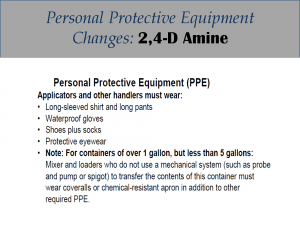 |
 |
 |
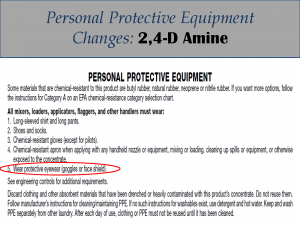 |
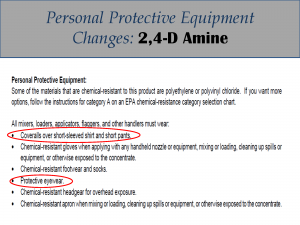 |
Note the Personal protective equipment changes from one year to the next for Endothall:
 |
 |
 |
 |
 |
If the herbicides used by applicators are safe, why do they need to wear all this PPE?
Herbicides, once diluted, are not hazardous to people in the area of application. The reason applicators are required to wear protective gear is because of 1) the applicator’s extreme exposure to herbicide in diluted and undiluted form, combined with 2) the duration of the applicator’s exposure while interacting with pesticides and herbicides on a daily basis.
There are safety numbers, documented by the EPA, for all of this. All pesticides must be registered with the EPA and there is a long series of rigorous tests that each material must go through prior to registration and authorization for use. It is from these scientific studies and resulting numerical thresholds for safety that bring forth the regulations of a pesticide label. Furthermore, it should be noted that the EPA errs 100 times on the side of safety when it comes to the use regulations.
When all is said and done, complacency and/or gross negligence are the enemies when it comes to FIFRA and the safe application of pesticides.
The applicator is the one charged with reading the label & complying with the label on the container he is using that day. Not yesterday’s container label. Not the memory of a label. Not what the applicator’s co-worker advised. This is the point and the goal of the licensing process. The overarching goal of the FDACS licensing requirement is for the purpose applicators be tested and certified capable of properly reading and interpreting the label.
Label interpretation is key to being a successful, accurate, and legal applicator.
A good amount of training, beyond the basics of applicator licensing, is required to appropriately interpret the law as it is printed on the label.
At AAM, we do not stop with the state-required basic training of the licensing process. That is why we continue to attend training events and advance the training of our applicators. When our understanding falls short, we contact UF/IFAS CAIP and refer to “higher powers” for the proper interpretation of the law.
Sometimes reading isn’t enough. Consider the following environmental hazards labeling for the herbicide, Endothall. The following, underlined in red, gave AAM pause:
After a good bit of investigation into the matter AAM was able to determine, in concert with the herbicide manufacturer, UPI, it was not the intent to indicate the treated water was harmful to livestock and other wildlife.
Clarification letters cited below to more accurately explain the intent of the manufacturer:
Only if the pond treated were the sole source of water for livestock would the herbicide application be in violation of the regulation. In this scenario, even with a regulatory violation, the livestock would have to consume an impossible amount of water to become sick as the herbicide thresholds and guidelines for application err 100 times on the side of caution when it comes to protecting wildlife.
Nevertheless, the statement as it appeared on the label, would open AAM up to misuse violation if, say, Mrs. Jones’ dog made its way down to the waterline and drank from the pond. There was no true hazard given incidental exposure, but the label made the statement and the label, not the letters of clarification from the manufacturer, is legally binding. Had Mrs. Jones’ dog become sick and AAM had treated with Endothall, AAM would be cited for herbicide misuse.
To put our exceptional conscientiousness into perspective, no other company, previous to AAM raising the question with UPI, ever took note of the line, and requested the manufacturers clarify the statement: “Do not use water from treated areas for watering livestock.”
UF/IFAS CAIP knows that AAM is the company that sincerely endeavors to get it right. This is why AAM was asked to give this presentation: “Why It’s So Important to Read Labels CAREFULLY AND FREQUENTLY” at SEHAC. We are the company that cares so much about safety of our employees and our customers that we go the extra mile when others simply do not.
Now, after years of training and experience, the pendulum has started to swing the other way and, on occasion, UF Doctorate professors will call AAM for regulatory insight.
Frequent label reading is key to being a successful and legal applicator.
Just as key as reading and interpreting a label carefully is the necessity in frequency of label reading. The labels DO change and the label is the law. The first thing we look at, prior to application, is whether or not the product is labeled for the site in question.
Note the following labels are from the same manufacturer for an identical herbicide, Imazapyr. Use the following labeled Imazapyr for aquatic applications and you will be in violation of federal law:
Use the following labeled Imazapyr for aquatic applications and you will be in compliance with federal law:
What’s the reason for the difference between these labels? Aside from marketing purposes, nothing. Even so, the label is the law and the law must be followed, always.
This is what we train our people to do: If the herbicide is not labeled for the site, it may not be used. There is no reason to read the PPE section. There is no reason to read the application rate section. The herbicide being used may be identical in composition and safe, in every practical way, for use. It may be less expensive than the one labeled for aquatic use. Pondering such practical questions is of ZERO use. We might as well be pondering why a particular speed limit is 55 and not 60. It doesn’t matter. The speed limit is posted and it is the law.
Adherence over convenience
We are bound as professional applicators to follow the language on the label. The label is the law and AAM abides by the law, always. This is our duty even when it is highly inconvenient.
When AAM was contracted to treat Lake Tohopekaliga ( Lake Toho) for hydrilla, so much herbicide quantity was required that the supplier was pulling from older warehouse stock to supply AAM. AAM ended up with three differing labels for the same herbicide. The only way AAM knew this is, as we train our applicators to do, we read the darn things from the container on the job site. Many folks do not. They go by memory. They go by assumption. They go by what their co-workers have stated. This is incorrect. The label is the law and AAM follows the law, always.
There are instances, as in with Government contract work, where a customer will purchase the herbicides for AAM to apply. These larger institutions may be able to purchase the herbicides at lower costs due to contracts with suppliers. It has occured on many occasions where AAM has received the herbicides, but has not applied the herbicides provided. This is because the institution failed to purchase herbicides that were labeled in compliance with the intended site use. This isn’t a path toward popularity for AAM. It is HIGHLY inconvenient. However, the label is the law and AAM follows the law, always.
Are the herbicides AAM applies toxic?
There is an old phrase, “The poison is in the dose.” This is true.
Anything can become a poison to humans and wildlife, including water, if consumed in too great a quantity. Yes, you can kill yourself by drinking too much good ol H2O. It’s called water intoxication, also known as water poisoning, hyperhydration, overhydration, or water toxemia. The same is true of salt. Like water, the human body requires salt to live. Ingest too much salt and you will die.
All herbicides are pesticides, but not all pesticides are herbicides. AAM uses only herbicides. On the tox tables, most herbicides are salts. They are a salt derivative of a compound. Table salt (NaCl) is more toxic to human beings than any herbicide AAM uses. People put table salt on their food, but they do so in a far lower dose than the toxic level. Apples to apples, if you are exposed to an equal amount of salt of Endothall (herbicide) and an equal amount of sodium chloride (table salt) the table salt is more toxic to you.
Herbicides work, primarily, by interfering with the process of photosynthesis. There is an amino acid within the process of photosynthesis that exists only in plants and not in other life forms to which the herbicide binds itself and stops the chain reaction of photosynthesis.
Bottom line: Unless you photosynthesise, herbicides administered properly according to the labeling are of no reasonable danger to you.
What can a homeowner look out for to protect themselves from herbicide misuse?
You can ask your applicator, himself, “Are you licensed?” Legally FDACS will allow for one licensed applicator to supervise up to 15 non-licensed applicators. Most companies do this. They will have one guy sitting in an office who is licensed who sends his non-licensed untrained applicators to execute his orders.
Not so with AAM. Every single AAM applicator is a state licensed applicator with a high degree of training. AAM, with over 90 applicators, very likely has more licensed applicators than any other entity in the state and aside from CA and NY, no other state is as strict as Florida in their regulations.
Full circle
I will leave you where we began. Hopefully you now better understand and appreciate the sincere commitment behind our words when we say:
At AAM, we’re ethical & environmentally conscious. Our commitment to safety and the environment is evident in our daily business practices. We’re passionate about conducting vegetation control while protecting the environment, we use only EPA registered herbicides, and we are 100% compliant with pesticide regulations to the letter of the label. When you choose AAM, you can rest assured that you’re making a conscious decision to help protect the environment.




